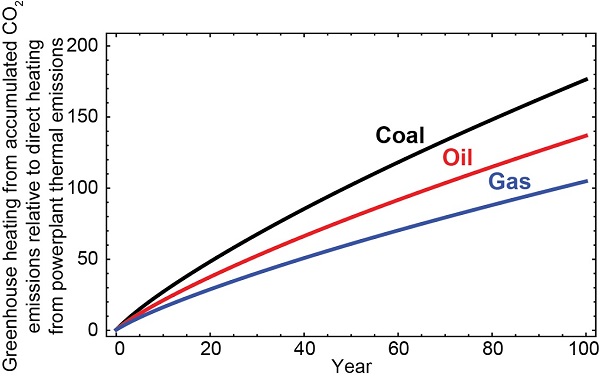Washington, DC—The heat generated by burning a fossil fuel is surpassed within a few months by the warming caused by the release of its carbon dioxide into the atmosphere, according to new work from Carnegie’s Xiaochun Zhang and Ken Caldeira published in Geophysical Research Letters, a journal of the American Geophysical Union. The release of CO2 into the atmosphere contributes to the trapping of heat that would otherwise be emitted into outer space.
When a fossil fuel is combusted, heat is released. Some of this is used to make electricity or heat human-built structures, but eventually all of that energy escapes into the environment and warms the planet. But this combustion process also produces carbon dioxide, which is a greenhouse gas that accumulates in the atmosphere for thousands of years and traps heat that would otherwise escape into space, causing global climate change.
In a modeling study of coal, oil, and natural gas, Zhang and Caldeira compared the warming caused by combustion to the warming caused by the carbon dioxide released by a single instance of burning, such as one lump of coal, and by a power plant that is continuously burning fuel.
They found that the carbon dioxide-caused warming exceeds the amount of heat released by a lump of coal in just 34 days. The same phenomenon is observed in 45 days for an isolated incident of oil combustion, and in 59 days for a single instance of burning natural gas.
“Ultimately, the warming induced by carbon dioxide over the many thousands of years it remains in the atmosphere would exceed the warming from combustion by a factor of 100,000 or more,” Caldeira said.
For a power plant that is continuously burning, the warming caused by atmospheric carbon dioxide exceeded the heat released into the atmosphere by combustion in less than half a year—just three months for coal plants. With this kind of steady continuous combustion, it takes 95 days using coal, 124 days using oil, and 161 days using natural gas.
Caldeira explained: “If a power plant is burning continuously, within 3 to 5 months, depending on the type of power plant, the CO2 from the power plant is doing more to heat the Earth than the fires in its boiler. As time goes on, the rate of burning in the power plant stays the same, but the CO2 accumulates, so by the end of the year, the greenhouse gases will be heating the Earth much more than the direct emissions from the power plant.”
“It’s important to note that heat emissions from combustion are not negligible, particularly in urban areas,” Zhang added. “But carbon dioxide-caused warming is just that much greater. Our results drive home the urgency of cutting emissions immediately.”

Caption: Ratio of warming from accumulated atmospheric carbon dioxide to warming from combustion for coal, oil, and gas plants over time. Figure is simplified from Zhang and Caldeira’s paper (ERL, 2012)’.
Top Image Caption: Petr Kratochvil, publicdomainpictures.net.
__________
Funding for this work was provided by the Fund for Innovative Climate and Energy Research (FICER) and the Carnegie Institution for Science.
The data that used to calculate thermal emissions with thermal contents of fossil fuels and estimate CO2 emissions are available from IPCC AR5 (https://www.ipcc.ch/pdf/assessment-report/ar5/wg3/ipcc_wg3_ar5_chapter7.pdf). The historical CO2 emissions data from the Carbon Dioxide Information Analysis Center (CDIAC) fossil-fuel CO2 emissions dataset, and can be accessed via http://cdiac.ornl.gov/ftp/ndp030/CSV-FILES/global.1751_2008.csv.
